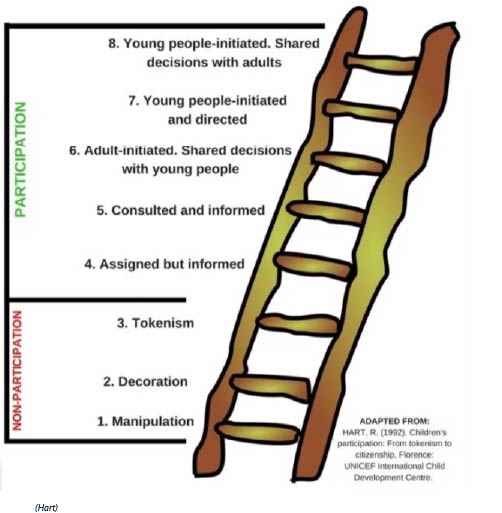Youth Engagement
Research shows that youth engagement contributes to higher academic competency and motivation, improved graduation rates, and a positive school climate.
OSPI is committed to authentically engaging students and young adults to share their experience, strength and hope and help build statewide supports for schools to create environments that incorporate student engagement in meaningful ways.
Youth Engagement and Hart’s Ladder
Roger Hart’s ladder of children’s participation is adapted from Sherry Arnstein’s “ladder of citizen participation” (1969) which related to citizen involvement in planning processes in the United States.
Hart’s model (1992) has eight rungs and two main zones he calls ‘Non-Participation’ and ‘Degrees of Participation.’ The top five rungs, in the ‘Participation’ zone all represent different but valid forms of participation while the three lowest rungs are all designated as “non-participation.” Though authentic engagement doesn’t mean you should reach the top rung of the ladder, the goal is to stay out of the non-participation rungs.

Source: Ladder of Children's Participation – Organizing Engagement

Since 2004, MENTOR Washington has been a key supporter of mentoring programs across the state. They assist over 150 organizations by providing training, building capacity, offering funding, developing resources, and ensuring quality.
To learn more about their work or to find out how you can become a mentor, visit www.mentorwashington.org.
- Youth Engagement Resources
- Mentoring
-
- Youth Mentoring at Community for Youth
- Boys & Girls Club Year 2 Report
- Career Integrated Mentoring
- 5th Edition of Elements of Effective Practice for Mentoring -MENTOR's key publication, the Elements of Effective Practice for Mentoring™, provides guidelines based on research and expert approval for creating and maintaining high-quality youth mentoring programs. These standards help build strong and impactful mentoring relationships. The Fifth Edition was released in January 2025, and it includes the latest research, practices, and insights in the mentoring field.






